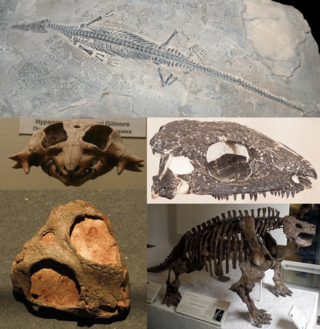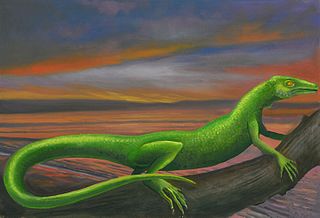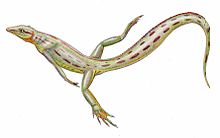
Diapsids are a clade of sauropsids, distinguished from more primitive eureptiles by the presence of two holes, known as temporal fenestrae, in each side of their skulls. The group first appeared about three hundred million years ago during the late Carboniferous period. All diapsids other than the most primitive ones in the clade Araeoscelidia are sometimes placed into the clade Neodiapsida. The diapsids are extremely diverse, and include birds and all modern reptile groups, including turtles, which were historically thought to lie outside the group. Although some diapsids have lost either one hole (lizards), or both holes, or have a heavily restructured skull, they are still classified as diapsids based on their ancestry. At least 17,084 species of diapsid animals are extant: 9,159 birds, and 7,925 snakes, lizards, tuatara, turtles, and crocodiles.

Mesosaurs were a group of small aquatic reptiles that lived during the early Permian period (Cisuralian), roughly 299 to 270 million years ago. Mesosaurs were the first known aquatic reptiles, having apparently returned to an aquatic lifestyle from more terrestrial ancestors. It is uncertain which and how many terrestrial traits these ancestors displayed; recent research cannot establish with confidence if the first amniotes were fully terrestrial, or only amphibious. Most authors consider mesosaurs to have been aquatic, although adult animals may have been amphibious, rather than completely aquatic, as indicated by their moderate skeletal adaptations to a semiaquatic lifestyle. Similarly, their affinities are uncertain; they may have been among the most basal sauropsids or among the most basal parareptiles.

Youngina is an extinct genus of diapsid reptile from the Late Permian Beaufort Group of the Karoo Red Beds of South Africa. This, and a few related forms, make up the family Younginidae, within the Order Eosuchia. Eosuchia, having become a wastebasket taxon for many probably distantly-related primitive diapsid reptiles ranging from the Late Carboniferous to the Eocene, Romer proposed that it be replaced by Younginiformes.

Petrolacosaurus is an extinct genus of diapsid reptile from the late Carboniferous period. It was a small, 40-centimetre (16 in) long reptile, and one of the earliest known reptile with two temporal fenestrae. This means that it was at the base of Diapsida, the largest and most successful radiation of reptiles that would eventually include all modern reptile groups, as well as dinosaurs and other famous extinct reptiles such as plesiosaurs, ichthyosaurs, and pterosaurs. However, Petrolacosaurus itself was part of Araeoscelida, a short-lived early branch of the diapsid family tree which went extinct in the mid-Permian.
Varanopidae is an extinct family of amniotes that resembled monitor lizards and may have filled a similar niche, hence the name. Typically, they are considered synapsids that evolved from an Archaeothyris-like synapsid in the Late Carboniferous. However, some recent studies have recovered them being taxonomically closer to diapsid reptiles. A varanopid from the latest Middle Permian Pristerognathus Assemblage Zone is the youngest known varanopid and the last member of the "pelycosaur" group of synapsids.

Parareptilia ("near-reptiles") is a subclass or clade of basal sauropsids/reptiles, typically considered the sister taxon to Eureptilia. Parareptiles first arose near the end of the Carboniferous period and achieved their highest diversity during the Permian period. Several ecological innovations were first accomplished by parareptiles among reptiles. These include the first reptiles to return to marine ecosystems (mesosaurs), the first bipedal reptiles, the first reptiles with advanced hearing systems, and the first large herbivorous reptiles. The only parareptiles to survive into the Triassic period were the procolophonoids, a group of small generalists, omnivores, and herbivores. The largest family of procolophonoids, the procolophonids, rediversified in the Triassic, but subsequently declined and became extinct by the end of the period.

Procolophonia is an extinct suborder (clade) of herbivorous reptiles that lived from the Middle Permian till the end of the Triassic period. They were originally included as a suborder of the Cotylosauria but are now considered a clade of Parareptilia. They are closely related to other generally lizard-like Permian reptiles such as the Millerettidae, Bolosauridae, Acleistorhinidae, and Lanthanosuchidae, all of which are included under the Anapsida or "Parareptiles".

Younginiformes is a group of diapsid reptiles known from the Permian-Triassic of Africa and Madagascar. It has been used as a replacement for "Eosuchia". Younginiformes were historically suggested to be lepidosauromorphs, but were later suggested to be basal non-saurian neodiapsids. The group is sometimes divided into two families, Tangasauridae and Younginidae. The monophyly of the group is disputed. A 2009 study found them to be an unresolved polytomy at the base of Neodiapsida, while a 2011 study recovered the group as paraphyletic. A 2022 study recovered the Younginiformes as a monophyletic group of basal neodiapsid reptiles, also including Claudiosaurus and Saurosternon as part of the group. Some younginiforms like Hovasaurus and Acerosodontosaurus are thought to have had an amphibious lifestyle, while others like Kenyasaurus, Thadeosaurus and Youngina were probably terrestrial.

Procolophonomorpha is an order or clade containing most parareptiles. Many papers have applied various definitions to the name, though most of these definitions have since been considered synonymous with modern parareptile clades such as Ankyramorpha and Procolophonia. The current definition of Procolophonomorpha, as defined by Modesto, Scott, & Reisz (2009), is that of as a stem-based group containing Procolophon and all taxa more closely related to it than to Milleretta. It constitutes a diverse assemblage that includes a number of lizard-like forms, as well as more diverse types such as the pareiasaurs. Lee 1995, 1996, 1997 argues that turtles evolved from pareiasaurs, but this view is no longer considered likely. Rieppel and deBraga 1996 and deBraga and Rieppel, 1997 argue that turtles evolved from sauropterygians, and there is both molecular and fossil (Pappochelys) evidence for the origin of turtles among diapsid reptiles.

Thadeosaurus is an extinct genus of diapsid reptile belonging to the family Younginidae. Fossils have been found in the Lower Sakamena Formation of the Morondava Basin, Madagascar in 1981, and date to the late Permian to the early Triassic period.

Araeoscelidia or Araeoscelida is a clade of extinct diapsid reptiles superficially resembling lizards, extending from the Late Carboniferous to the Early Permian. The group contains the genera Araeoscelis, Petrolacosaurus, the possibly aquatic Spinoaequalis, and less well-known genera such as Kadaliosaurus and Zarcasaurus. This clade is usually considered to be the sister group to all later diapsids.

Acerosodontosaurus is an extinct genus of neodiapsid reptiles that lived during the Late Permian of Madagascar. The only species of Acerosodontosaurus, A. piveteaui, is known from a natural mold of a single partial skeleton including a crushed skull and part of the body and limbs. The fossil was discovered in deposits of the Lower Sakamena Formation. Based on skeletal characteristics, it has been suggested that Acerosodontosaurus individuals were at least partially aquatic.

Owenetta is an extinct genus of owenettid procolophonian parareptile. Fossils have been found from the Beaufort Group in the Karoo Basin of South Africa. Although most procolophonians lived during the Triassic, Owenetta existed during the Wuchiapingian and Changhsingian stages of the Late Permian as well as the early Induan stage of the Early Triassic. It is the type genus of the family Owenettidae, and can be distinguished from other related taxa in that the posterior portion of the supratemporal bears a lateral notch and that the pineal foramen is surrounded by a depressed parietal surface on the skull table.

Reptiles arose about 320 million years ago during the Carboniferous period. Reptiles, in the traditional sense of the term, are defined as animals that have scales or scutes, lay land-based hard-shelled eggs, and possess ectothermic metabolisms. So defined, the group is paraphyletic, excluding endothermic animals like birds that are descended from early traditionally-defined reptiles. A definition in accordance with phylogenetic nomenclature, which rejects paraphyletic groups, includes birds while excluding mammals and their synapsid ancestors. So defined, Reptilia is identical to Sauropsida.

Orovenator is an extinct genus of diapsid from Lower Permian deposits of Oklahoma, United States. It is known from two partial skulls from the Richards Spur locality in Oklahoma. The holotype OMNH 74606 consists of a partial skull preserving snout and mandible, and the referred specimen, OMNH 74607, a partial skull preserving the skull roof, vertebrae and palatal elements. It was first named by Robert R. Reisz, Sean P. Modesto and Diane M. Scott in 2011 and the type species is Orovenator mayorum. The generic name means "mountain", oro, in Greek in reference to the Richards Spur locality, which was mountainous during the Permian period and "hunter", venator, in Latin. The specific name honours Bill and Julie May. Orovenator is the oldest and most basal neodiapsid to date.
Lanthanolania is an extinct genus of diapsid from Middle Permian deposits of Arkhangel'sk Province, Russia. It is known from the holotype and only specimen PIN 162/56, a nearly complete skull from the Glyadnaya Shchelya locality, Mezen river in Mesen District. It was first named by Sean P. Modesto and Robert R. Reisz in 2003 and the type species is Lanthanolania ivakhnenkoi.

Ankyramorpha is an extinct clade of procolophonomorph parareptiles which lived between the early Cisuralian epoch and the latest Triassic period of Africa, Antarctica, Asia, Australia, Europe, North America and South America.
Tangasaurus is an extinct genus of aquatic basal tangasaurid neodiapsid known from the Late Permian period of Tanga, northeastern Tanzania. It contains a single species, Tangasaurus mennelli.
Kenyasaurus is an extinct genus of basal tangasaurid known from the Early Triassic period of Coast Province, southeastern Kenya. It contains a single species, Kenyasaurus mariakaniensis.

Younginidae is an extinct family of diapsid reptiles from the Late Permian and Early Triassic. In a phylogenetic context, younginids are near the base of the clade Neodiapsida. Younginidae includes the species Youngina capensis from the Late Permian of South Africa and Thadeosaurus colcanapi from the Late Permian and Early Triassic of Madagascar. Heleosuchus griesbachi from the Late Permian of South Africa may also be a member of the family.




















